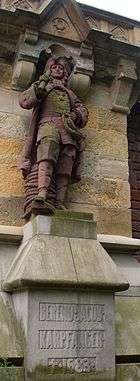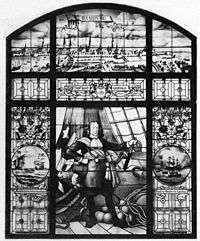Berend Jacobsen Karpfanger

Berend Jacobsen Karpfanger (1623-October 11, 1683) was a German admiral of the Hamburg Admiralty known for fighting pirates.[1] He was the captain of the convoy ships Leopold I and Wapen von Hamburg, which defended merchant ships from the pirates of the North African Barbary Coast.
Career

Karpfanger was born in Hamburg in 1623 into a seafaring family with Dutch roots.[2] He inherited a fleet of ships from his father, captaining these and scoring significant successes in fighting piracy. His fleet of ships expanded as he commandeered the ships he captured.
In 1674, he rose to the rank of admiral, becoming a Convoykapitän. This title was given to those captains of warships who escorted merchant ships along the traderoutes of the Hanseatic League. Karpfanger first took command of the ship Leopoldus Primus, later to be called Leopold I, and later on the Wapen von Hamburg, which launched in 1669. Commissioned in 1668 to protect the merchant ships from the Barbary corsairs, the Wapen was a 40 metres (130 ft) long warship with a total of 54 cannons, ranging from four to 18 pounds. Karpfanger took command of this ship in 1683, when Leopold I was being repaired.
Karfanger was with the ship on 10 October 1683. On that day, while the ship was in the port of Cadiz, a fire started in the bow of the frigate that spread quickly throughout the rest of the ship. The crew tried desperately to fight the fire and when they could not contain it attempted to abandon ship on sloops. Karpfanger himself refused to abandon the ship while efforts continued to save it and commanded the crew to return to further fight the fire. Around midnight, the fire reached the ship's gunpowder magazine, causing the ship to explode. Admiral Karfanger was among the dead, alongside 22 soldiers and 42 crewmen. His body was found floating on the mooring line of an English ship in the harbor the following morning. The cause of the fire was never discovered.
Legacy
Karfanger was buried with honor at the cemetery in Cadiz, with a monument ordered at his tomb in his honor by Charles II of Spain. In 1808, the cemetery was moved by the French to allow them to expand the fortress. In 1897, Hamburg honored its famous son with a monument designed by R. Okelmann. In 1937, the Hamburg America Line purchased the Finnish freighter L'Avenir and rechristened it Admiral Karpfanger in his name.
Notes
- ↑ Erik Verg (1977). Das Abenteuer, das Hamburg heisst. Hamburger Abendblatt. p. 80.
- ↑ Geschichte, Verein für Hamburgische (1882). Mittheilungen. p. 2.
Additional sources
- Ernst Baasch: Hamburgs Convoyschiffahrt und Convoywesen. Ein Beitrag zur Geschichte der Schiffahrt und Schiffahrtseinrichtungen im 17. und 18. Jahrhundert, Hamburg 1896
- Reinhold von Werner: Admiral Karpfanger. Eine Erzählung aus Hamburgs Vorzeit, München 1899.
- Oskar G. Foerster: Admiral Karpfanger. Vom heldischen Leben und Sterben eines deutschen Seemannes, Berlin 1941.
- Ulrich Komm: Mit Breitseite und Enterbeil. Militärverlag der DDR 1971 (Roman unter Beachtung der historisch belegten Fakten)
- Wolfgang Quinger: 'Wappen von Hamburg' I. Ein Konvoischiff des 17. Jahrhunderts, Hinstorff Verlag, Rostock 1980.